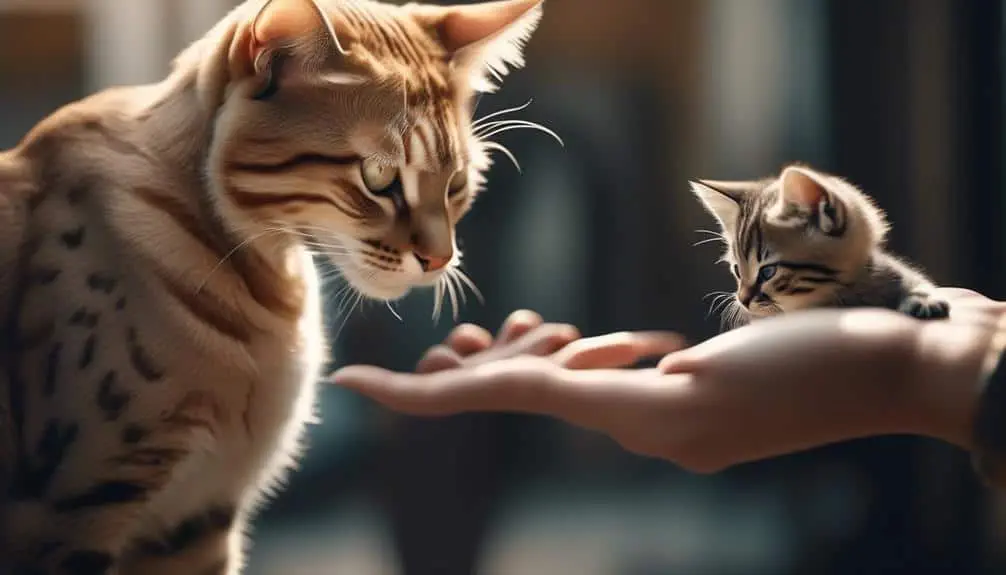The Best Fluffy Pancakes recipe you will fall in love with. Full of tips and tricks to help you make the best pancakes.

Cats, with their enigmatic nature and independent spirit, have long intrigued and captivated us. Yet, one aspect of their behavior remains elusive and puzzling – their resistance to paw handling.
What lies behind this mysterious behavior? Why do cats instinctively recoil or become defensive when it comes to their paws?
In this exploration, we will uncover the underlying reasons that contribute to this resistance, shedding light on the intricate relationship between cats and their paws. Prepare to be intrigued as we unravel the secrets that lie within our feline companions' paws.
Key Takeaways
- Cats' paws are highly sensitive and can feel discomfort even with slight pressure or touch.
- Avoiding paw handling may indicate pain or injury, as cats hide their pain well.
- Cats may resist having their paws touched as a defense mechanism, as their claws are their primary weapon.
- Traumatic experiences or past injuries can make cats wary of paw handling, requiring patience and trust-building.
Sensitivity of Cat Paws
The sensitivity of cat paws is a crucial aspect of their anatomy, allowing them to navigate their environment and detect changes in texture and stability.
Cats' paws are equipped with numerous nerve endings that make them highly sensitive to pressure, vibration, and temperature changes. This sensitivity enables cats to feel the ground beneath them and adjust their movements accordingly.
However, even a brush or slight press can cause discomfort for cats, as their paw pads are extremely sensitive.
It is important for cat owners to be mindful of signs of paw discomfort, such as limping or reluctance to use a particular foot. These signs may indicate injury or pain, and prompt attention to cat paw care is necessary to ensure their well-being.
Paw Injuries and Pain
Cats that exhibit resistance to having their paws handled may be indicating the presence of injuries or pain. It is important to understand that cats are masters at hiding pain, making it difficult to detect injuries.
However, there are signs that can indicate pain in cats, such as limping or reluctance to use a specific foot. If a cat shows a change in behavior or displays these signs, it is advisable to take them to the veterinarian for a check-up.
Preventing paw injuries is crucial for maintaining the overall health and well-being of cats. Regular trimming of their claws and providing appropriate scratching surfaces can help prevent injuries. Additionally, monitoring their activity levels and providing a safe environment can also minimize the risk of paw injuries.
Defense Mechanism
Cats' natural defense mechanism involves utilizing their claws as a primary weapon, enabling them to be prepared for potential threats. This behavior is deeply rooted in their feline instincts.
When cats feel their paws being held or touched, they may perceive it as a form of restraint, triggering feelings of vulnerability. Holding their paws can make them feel trapped and unable to use their claws if needed for defense.
Additionally, cats' paws are highly sensitive, filled with nerve endings that allow them to detect changes in texture and stability. Any pressure or touch on their paws can be uncomfortable and overwhelming.
Furthermore, past traumatic experiences, such as accidents or abuse, can imprint fear and unease, causing cats to resist paw handling. Understanding these factors is crucial in respecting cats' boundaries and building trust with them.
Past Traumatic Experiences
Past traumatic experiences can create lasting fear and unease, causing cats to become wary of having their paws handled. Cats that have experienced accidents or abuse may associate paw handling with pain and distress. Rebuilding trust and overcoming fear in cats with past traumatic experiences requires patience and understanding.
Here are three ways to help cats rebuild trust and become comfortable with paw handling again:
- Gradual desensitization: Introduce paw handling in small, non-threatening increments, such as gently touching the paw for a brief moment. Gradually increase the duration and intensity of the handling as the cat becomes more comfortable.
- Positive reinforcement: Use treats, praise, and rewards to create a positive association with paw handling. Reward the cat for allowing their paws to be touched, reinforcing the idea that it's a safe and pleasant experience.
- Respect boundaries: Allow the cat to set the pace and never force paw handling. Respecting their comfort level and providing a safe and calm environment will help them feel more secure.
Building Trust
Establishing a foundation of trust is crucial when it comes to handling a cat's paws. Building trust with a cat requires patience, understanding, and respect for their boundaries. Gaining a cat's confidence takes time, especially if they have experienced trauma in the past.
It is essential to allow the cat to adjust at their own pace and not force any interactions. Respecting their comfort level is paramount in establishing trust. By providing a safe and calm environment, offering positive reinforcement, and gradually introducing paw handling, the cat can begin to feel more comfortable and secure.
Setting and respecting boundaries will help the cat feel in control, reducing their stress and increasing their trust in their human caretaker.
Conclusion
In conclusion, the resistance of cats to having their paws handled can be attributed to a combination of factors including the sensitivity of their paws, past traumatic experiences, and their defense mechanisms.
Understanding these reasons is crucial for improving the well-being and relationship between cats and their owners. By building trust, addressing potential injuries or pain, and respecting their personal preferences, cat owners can create a harmonious environment that promotes the overall happiness and comfort of their feline companions.








